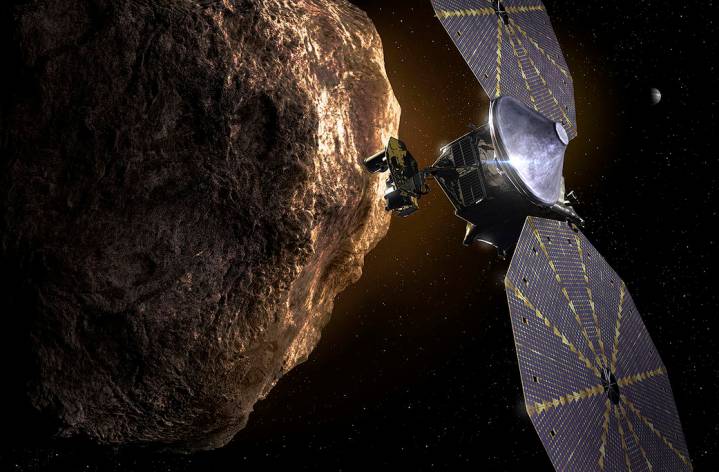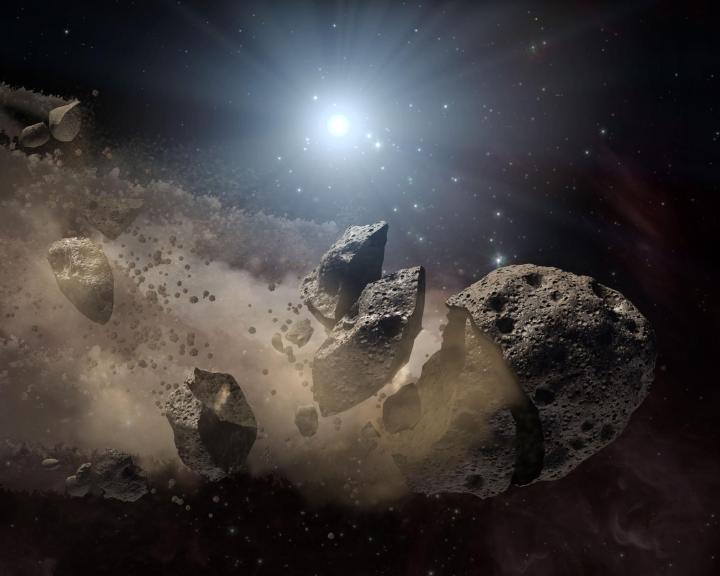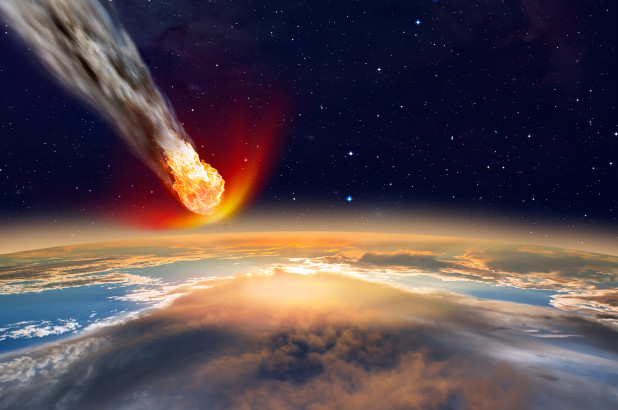Sabina Raducan has the kind of job you’d expect the protagonist in a 1990s Michael Bay movie to hold. In The Rock, Nicolas Cage’s Dr. Stanley Goodspeed is an FBI chemical weapons specialist who helps save the day. In Armageddon, Bruce Willis’ Harry Stamper is a veteran oil driller who helps save the day. And at the University of Bern, one of the largest universities in Switzerland, Sabina Raducan builds hyper-realistic models of asteroid impacts. Which could one day help save, well, our entire planet.
To be clear, Raducan isn’t building models of what would happen in the event that an asteroid collided with Earth. Instead, as a postdoctoral researcher, she builds numerical simulations of what would happen if we (meaning Earth) attempted to deflect a destructive asteroid by sending a human-made “impactor” device up to greet it. Rather than destroy it, this could be used to nudge the asteroid off-course so that it sails past our planet.

For now, the idea of having something like this as a precautionary measure is still in the future. When it happens though (and it’s likely a “when” rather than an “if”), Raducan’s work may prove invaluable. And, for now at least, her research gives her an envy-inducing icebreaker for parties: “I work in the planetary defense sector.”
The golden age of asteroids
Raducan became fascinated by the subject of impact cratering when she was completing a master’s degree in Astronomy, Space Science, and Astrophysics at the U.K.’s University of Kent. “Everyone was interested in Mars and the Moon,” she told Digital Trends. “That’s where all the research goes. I wanted to do something that was not overpopulated with scientists, and is [much] less studied.”

Scientists have been wondering about the possibility of protecting Earth against possible killer asteroids for more than half a century. In the mid-1960s, many people were worried about the possibility of Asteroid 1566 Icarus colliding with the Earth, despite the fact that experts were confident it would pass only within around four million miles. “Large Asteroid is Headed for Earth” screamed one newspaper. “Hippies Flee to Colorado as Icarus Nears Earth,” wrote no less an authority than the New York Times.
At MIT, researchers drew up plans to blow up Icarus using six Saturn V rockets, armed with separate 100-megaton nuclear warheads. As expected, Icarus wound up missing Earth – although the MIT work, described in more detail in the book Fire in the Sky, generated no shortage of press coverage.
But while there have since been periodic surges of coverage for this topic, and no shortage of Hollywood movies (most recently Don’t Look Up), Raducan is confident that she has entered the field at the right time.
Asteroid supermodels
One reason for this is the quantity of space missions and the resultant data. “Fifteen years ago there was such limited data [about asteroids],” she said. “Now we have multiple space missions that go to asteroids and a lot of data that comes in. There’s DART and Hera. There’s the Lucy mission. There are the OSIRIS-REx and Hayabusa missions. There’s the Psyche mission. All of this is data you couldn’t get from Earth.”
Interestingly, not all of the data used for building Raducan’s models can come from real-life asteroids. Recently some of her colleagues trekked to Spain where they fired plastic projectiles at a substitute scale model of the asteroid Ryugu, made of sand and rocks, using a compressed gas gun. These results also make their way into her computer models.

The second, complementary reason that now is the best time ever to study asteroids is the Moore’s Law-driven march of technological progress. An asteroid impact simulation that, to use the same 15-year comparison mentioned earlier, would have taken a week to process in 2007 now takes around half an hour. And the simulations that currently take a week are far, far superior in their complexity.
The TL;DR version? We know more about asteroids and, in the words of The Six Million Dollar Man intro, we can rebuild them. Or at least model them in impressively high resolution on a supercomputer.
A question of force
There are currently no asteroids that scientists worry pose an immediate threat to life on Earth. There is no immediate race against the clock to build a planetary defense system. But models like Raducan’s will help us better understand how to deal with asteroids in the event that we one day need to. They will also help us better model these threats, whether the asteroids in question turn out to be large, dense space rocks or accumulations of smaller rocks held together by gravity. Each of these would require different strategies, which is why computer modeling work such as this is so important.
It’s easy to think that, when it comes to possible killer asteroids, we should simply hit them as hard as we can. After all, the concept of overkill, exceeding the amount of destructive capacity needed to solve the problem, doesn’t seem too much of an issue when you’re dealing with a potential extinction level event hurtling towards Earth.

But in fact, this is not the case. Hitting an asteroid with insufficient force to deflect it would, obviously, be bad news. However, so too would hitting it with too much force – as anyone who has ever played the Atari game Asteroids will know.
“The problem is that if you hit it too hard, you’re just breaking it apart,” Raducan said. “Then instead of dealing with one object, you’re dealing with multiple smaller objects that are much harder to control. Instead of a single impact, you have a range of impacts. That is something you most definitely want to avoid.”
Proving the predictions
Of course, the big question about Raducan’s models is the same as with any predictive model: How accurate are they? Plenty of smart computer models, equipped with much larger quantities of data, have failed. Famously, Google Flu Trends – which used Google searches for flu-related queries – was wide of the mark when it came to accurately predicting the spread of the influenza virus during flu season.
How can Raducan be confident her models are accurate? After all, in the event of a killer asteroid, a miscalculation could be disastrous. For now, the answer is … we don’t know. But we very well could soon.
Last November, NASA launched its DART (Double Asteroid Redirection Test) mission. Hailed as the world’s first full-scale planetary defense test against the possibility of asteroid impacts, DART will collide with asteroid target Dimorphos sometime this September.
As part of her work, Raducan has helped to model the likely impact that DART will make on its target. Her predictions suggest that the DART mission will be extremely unlikely to break up the asteroid, although it will significantly deform it. To break it up would take 10x more impact energy. By analyzing the data from the DART mission – and the European Space Agency’s Hera mission to investigate the aftermath of the DART probe impact – it will be possible to get a sense of how well Raducan’s models predicted the impact.
Whatever the outcome, the resulting data will be used to make future models even more accurate.
Building a planetary defense system
Ultimately, the hope is that Raducan’s predictive asteroid impact models could form one key part of a planetary defense system able to keep Earth safe from the threat of future asteroid collisions.
Since the last extinction level asteroid impact took place roughly 66 million years ago, the probability of such an asteroid impact is thankfully low. (Although, as NASA notes, an asteroid the size of a car enters Earth’s atmosphere roughly once a year, but burns up before causing any damage.)

Nonetheless, given the potential damage a killer asteroid could cause, Raducan believes it’s a worthwhile investment to create the necessary safeguards – at least as far as missions like DART are concerned.
“The DART spacecraft is a very cheap mission compared to usual space missions, because it is a technology demonstration mission and not a science mission,” she said. “It only has a few instruments on board, such as a camera and a navigation system, and the duration of the mission is very short, [being] less than a year in space.”
At the end of the day, it all comes back to Michael Bay. “To put the cost of the DART mission in context, it costs about the same amount to produce a movie like Armageddon, as it costs to send an actual deflection mission in space,” Raducan said. “If it’s more important to film a Hollywood movie about an asteroid deflection than actually sending a spacecraft [to help us potentially do the same thing] we have to get our priorities right.”


